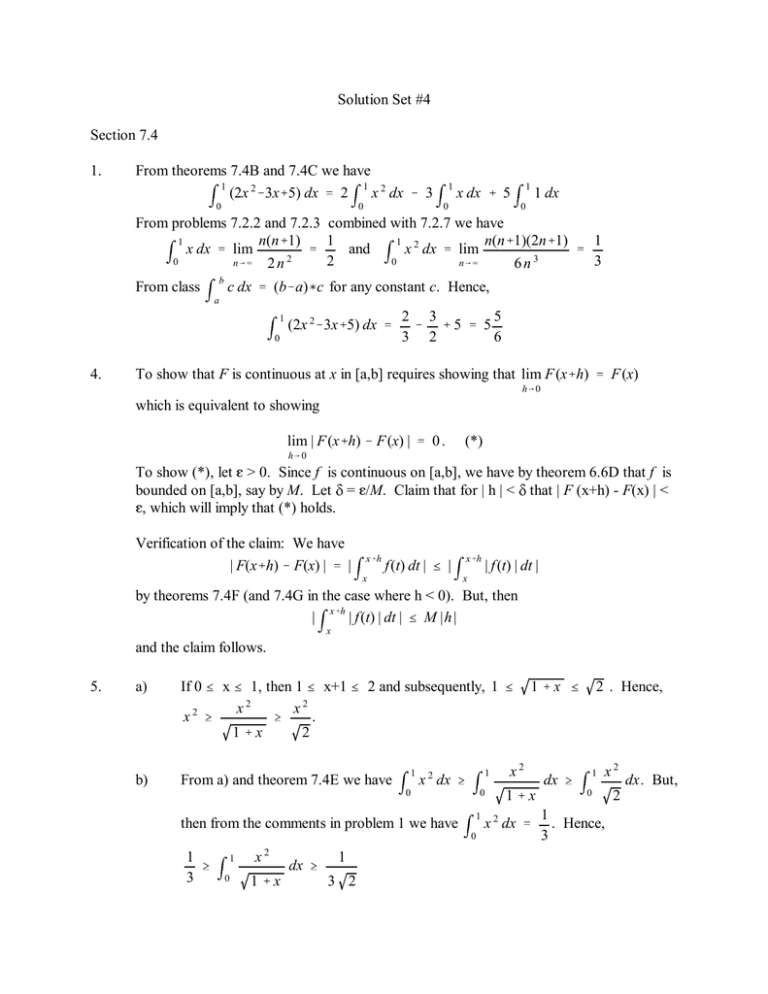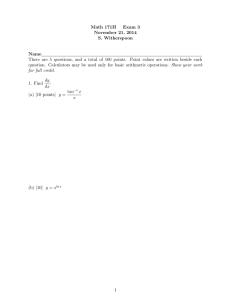x & 3 % 5 m
advertisement

Solution Set #4 Section 7.4 1. From theorems 7.4B and 7.4C we have 1 1 2 (2x 2&3x%5) dx ' 2 x dx m0 m0 &3 1 m0 %5 x dx 1 m0 1 dx From problems 7.2.2 and 7.2.3 combined with 7.2.7 we have n(n%1) 1 n(n%1)(2n%1) 1 1 2 x dx ' lim ' x dx ' lim and m0 m0 2 n 64 n 64 2n 2 6n 3 From class b ma c dx 3 ' (b&a)(c for any constant c. Hence, 1 m0 4. ' 1 (2x 2&3x%5) dx ' 2 & 3 %5 ' 55 3 2 6 To show that F is continuous at x in [a,b] requires showing that lim F (x%h) ' F (x) h60 which is equivalent to showing lim | F (x%h) & F (x) | ' 0. h60 (*) To show (*), let g > 0. Since f is continuous on [a,b], we have by theorem 6.6D that f is bounded on [a,b], say by M. Let = g/M. Claim that for | h | < that | F (x+h) - F(x) | < g, which will imply that (*) holds. Verification of the claim: We have | F(x%h) & F(x) | ' | x%h mx f (t) dt | #| x%h | f (t) | dt | mx by theorems 7.4F (and 7.4G in the case where h < 0). But, then x%h | | f (t) | dt | # M |h | mx and the claim follows. 5. a) If 0 # x # 1, then 1 # x+1 # 2 and subsequently, 1 2 x2 x2 $ $ x . 1%x 2 b) From a) and theorem 7.4E we have 1 m0 x 2 dx $ then from the comments in problem 1 we have 1 3 $ 1 m0 x 2 1%x dx $ 1 3 2 1 m0 1 m0 # 1 % x # 2 . Hence, x2 1%x x 2 dx dx $ 1 m0 x2 ' 1 . Hence, 3 2 dx . But, 7. If f is continuous at c in [a,b] and f (c) > 0, then there exists > 0 such on the interval J = B(c, ) 1 [a,b] we have f (x) > f (c)/2 > 0. Furthermore, note that |J| $ > 0. Let be f (c) (x) . Then, on [a,b] we the characteristic function of the interval J and let g(x) ' 2 have f (x) $ g(x). Hence, by theorem 7.4E we have b ma 8. g(x) dx b ma f (x) dx $ b ma g(x) dx . But, ' f (c) |J| > 0 . 2 Suppose to the contrary that f is not identically 0 on [a,b]. There, there exists a c in [a,b] b f (x) dx > 0 , which such that at c we have f (c) > 0. Then, by problem 7 we have ma contradicts the hypotheses of the problem. Section 7.5 1. Suppose f is the constant function f (x) = c. Then, for any x in [a,b] we have that f (x % h) & f (x) f ) (x) ' lim % lim c & c ' 0 . h h h60 h60 2. The hypothesis that f ’(c) exists means that lim 5. a) 7. Since f ’ (c) exists and since a < c < b, then the lemma on page 195 implies that there exists and interval (0, ) so that for all h 0 (0, ) we can write f (c % h) & f (c) exists. But, then the limit h h 60 f (c % h) & f (c) theorems imply that b lim ' lim b f (c % h) & b f (c) . But, since g(x) = h h h60 h60 bf (x) on an interval containing c, we have that g’ (c) exists and equals bf ’(c). Let m = -n. Then xn = 1/xm. If x ú 0, then theorem 7.5C (quotient rule) implies 1 &mx m&1 ' &m . But the latter term is nxn-1. that (x n)) ' ( )) ' xm x m%1 x 2m f (c + h) = f (c) + h F (h) (**) where F is continuous at h = 0 and F (0) = f ’(c) > 0. Since F is continuous at h = 0 and since F (0) > 0, there exists an interval (0, 1) on which F(x) > 0. Wolog we may take 1 < . Then, for all h 0 (0, 1) we have h F (h) > 0 and hence, from (**) f (c + h) > f (c). 9. False. Consider f (x)' 2x % x 2 sin 1 x , xú0 . Then, f is defined for all real x and f ’ 0 , x'0 exists for all real x and f ’ (0) > 0, but f is not strictly increasing on any open interval which contains 0. Section 7.6 1. Suppose to the contrary that there exists a k such that f (x) = x3 - 3x + k has two distinct roots in [0,1], say x1 and x2 with 0 # x1 < x2 # 1. Then, by Rolle’s theorem we have that f ' (x) = 3x2 - 3 has a root at some c in (x1, x2) d (0,1). But, the roots of f ' are ±1 which is a contradiction. 2. a) f (x) = sin x on [0, ]. Yes. f is continuous on [0, ] and differentiable on (0, ) and f (0) = 0 = f ( ). b) f (x) ' x (x & 1) on [0,1]. Yes. f is continuous on [0,1] and differentiable on (0,1) and f (0) = 0 = f (1). c) f (x) = sin 1/x on [-1/ , 1/ ], x ú 0; f (0) = 0. No. f is not differentiable at x = 0 and hence not on (-1/ , 1/ ). d) f (x) = x2 on [0,1]. No, f (0) ú f (1). 3. For f (x) = (x - a)(b - x) we have f ' (x) = a+b - 2x. So, c = (a+b)/2 satifies f ' (c) = 0 and c 0 (a,b). Section 7.7 1. a) f (x) = x/(x-1) on [0,2]. No. f is not defined at x = 1 and hence cannot be continuous or differentiable at x = 2. b) f (x) = x/(x-1) on [2,4]. Yes. f is continuous on [2,4] and differentiable on (2,4). c ' 1 % 3 satisfies the conclusion of the mean value theorem. c) f (x) = Ax + B on [a,b]. Yes. f is continuous on [a,b] and differentiable on (a,b). Any c 0 (a,b) satisfies the conclusion of the mean value theorem. d) f (x) = 1 - x2/ 3 on [-1,1]. No. f is not differentiable at x= 0 and hence, not on (-1,1). 2. a) c = 1/2 b) c = - / 4 3. If f ’(x) and g’(x) exist for all x in [a,b], then both f and g are both continuous on [a,b]. Furthermore, g’(x) ú 0 for all x in [a,b] implies that g(a) ú g(b) — otherwise, Rolle's would be contradicted. Finally, since g'(x) ú 0 for all x in [a,b], then we cannot have both f ' (t) = g'(t) = 0 for any t in (a,b). 4. Suppose f ' (x) = 0 for all x in (a,b). Let c be a specific (fixed) point in (a,b). Then, for any other point x in (a,b), x ú c, we have by the mean value theorem that f (x) & f (c) ' 0 (***) x&c But, (***) implies that f (x) = f (c). Therefore, f is constant on (a,b).







